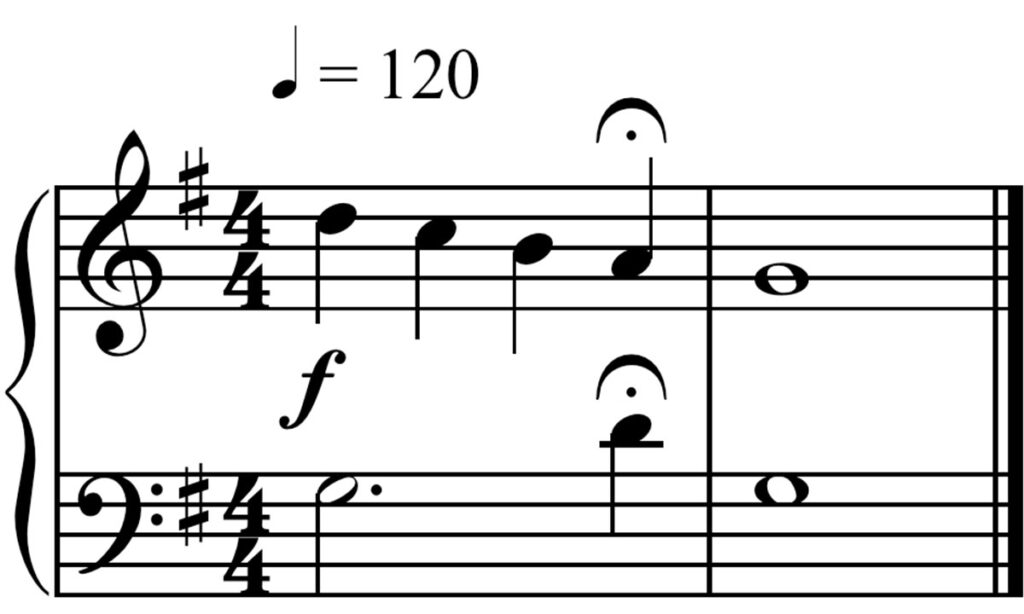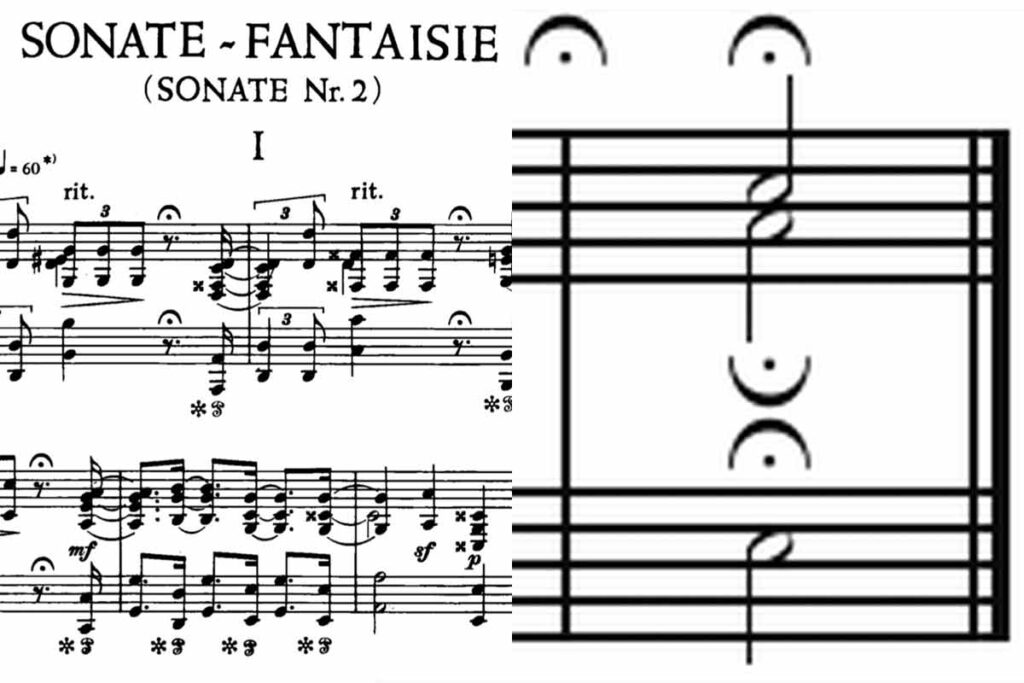The Quick Guide To Fermata In Music Notation

Fermata In Music Theory
A fermata is an Italian term and articulation mark used in music notation to prolong the length of a note or rest. This symbol defines how the music should be performed and effectively changes the beat of the music.
In English, a fermata is commonly called a pause or hold. It indicates that the note on which the fermata is placed should be extended beyond its regular duration.
The symbol for a fermata resembles an eye, which is why some musicians refer to it as the “eye of the music.”
This symbol requires musicians to pay more visible attention to the conductor, who often determines the length of the note with a fermata.
It is essential for every musician to understand what the fermata symbol means and how to respond when they see it in any musical context.
This article aims to guide you in achieving that understanding. We will learn about the fermata, its placement in staff music notation, and how long a fermata should be held, which is essentially its time value.
To start, we will define the fermata and then discuss its placement in staff music notation. Additionally, we will explore the duration for which a fermata should be held.
What Is A Fermata In Music?

A fermata is a musical symbol that indicates a note or rest should be held longer than its standard duration.
Often depicted as an eye-like shape, the fermata emerged around the 15th century and was notably used by composers like Josquin des Prez and Guillaume Du Fay.
It functions by extending the duration of a note or rest, pausing the music and directly altering its rhythmic flow.
Visually, it consists of a bold dot within a semicircle, whose position (above or below the dot) is determined by the note’s placement on the staff.
The positioning of the semicircle relative to the dot—whether above or below—depends on the fermata’s placement on the music staff.
In specific instances, the semicircle appears above the dot when the fermata is positioned above the note. Conversely, when placed below the note, as in multiple tones notation, the semicircle is situated below the dot.
Known by various names such as “Fermate” in German, “corona” in Italian, and “point d’orgue” in French, the fermata is also referred to as “suspensão” in Portuguese and “calderón” in Spanish.
Informally, it is sometimes called a “bird’s eye” or “eye of the music” during casual music discussions.
What Does a Fermata Mean In Music?

Fermata came from the Italian word “fermare” which simply means “to stay”, or “stop”. However, it means a stop, a pause, or hold in music.
For that reason, fermata means a pause of undefined length on a note, chord or rest in music.
Generally, this articulation mark empowers the music performer to hold a note, rest, or chord beyond its actual time value in notation.
Basically, fermata is used to prolongation of a tone, chord, or rest beyond its specified duration. The prolongation of a tone or rest as a result of fermata is based on the judgment of the performer.
Whenever we see a fermata symbol over or below a note or a group of notes or rest in a musical piece, it means we should prolong the note.
A fermata tells the performer to elongate a musical tone or rest more than the usual time value.
In a simple term, it means the performer should the note or rest longer than its normal time value.
Usage In Different Music Periods
Specifically, the fermata symbol means to hold the note or rest and pause the music.
Be that as it may, fermata has been used in different ways during the different eras of music.
For instance, most of the composers of the Baroque era like Johann Sebastian Bach used fermata in chorales to indicate the end of a phrase.
And that signifies that a breath should be taken to the music performer.
Sometimes the fermata is used after a Da Capo in place of Fine which is commonly used now to signify the end of a musical piece.
Moreover, in both the Baroque and classical music eras, fermatas were used at a point of cadenzas. Basically, they are used to indicate the point at which the cadenza begins.
Fermata Placement in Music Notation

Fermata is an articulation mark that means a hold or pause sign in music notation.
Fermata is represented with a dot and a semicircle is used with each and every rhythmic value be it single notes, intervals, chords or rests.
The question that needs a valid answer in this section of the article is Where do you place the fermata?
Basically, fermata is best placed above the note on the staff regardless of the note stem direction.
However, it is allowed to place it below the note in a situation where staff contains notes for multiple parts.
As a result, we can have it on the soprano note and below the alto note as shown in the diagram above.
Fermata should be placed directly on the exact note that is applied to. This is very important in order to avoid confusion.
For instance, confusion can arise whether the fermata on the whole note in the diagram below applies to the eighth rest below it.
Moreover, one fermata will take care of all notes in a chord or interval.
Placement Alignment
The fermata must be placed at the center of the notehead or rest. This is the case whether it is placed directly on the notehead or on the stem side.
Generally, the fermata must align with the center of the notehead whichever side of the note it is placed on.
In addition, the fermata should be placed outside the staff line whether it is placed above or below. Also, placed it after other articulation marks as well as slurs.
Placing Other Musical Terms With Fermata
Other terms like lunga (long) or poco (little) are sometimes used along with the fermata. This is done majorly for a more defined intent.
To properly used these other terms with the fermata, they should be placed in a central position above them.
Doing so means that the length of the note is at the discretion of the performer and does not correspond to the actual value of the note.
What Happened When Placed On Rest Or Caesura
When we see fermata on the rest as we have it in the diagram above, it elongates the silence and notes the sound.
As a result, the time value of the rest will be prolonged beyond the actual value.
As related to the caesura which denotes a brief period of undefined silent pause. In a simple term, it means a small break in the sound.
The special symbol for caesura is double oblique lines that look like a pair of forwarding slashes.
Just like fermata itself, the caesura’s duration is unspecified and only determined by the conductor of the performer.
Basically, when fermata is added to the caesura, the effect of silence is more elongated.
Fermata Time Value and Interpretation
Actually, there is a defined time value or beat count for every musical note that represents a tone in music notation.
But with the addition of fermata to the note, the time value of the note has been redefined.
In simple terms, fermata means we should hold out the note until when other musicians or conductor tells us to come back.
Basically, the time value of the note with fermata is elongated and how long it will sound is at the discretion of a performer.
Establishing a new time value in this case calls for proper interpretation of the music. This can be achieved by putting other aspects of music like tempo and rhythm into consideration.
In this section, we will look into the fermata time value and how we can properly interpret it.
Fermata Time Value
Specifically, the fermata symbol means to hold the note or rest and pause the music.
For instance, if we have a fermata placed over a Minim or Half Note, the performer plays or sings the note longer than 2 beats count.
But the question that needs a valid answer here is how long do we hold a note with a fermata?
In reality, the time value of a fermata note is undefined and only determined by the music performer.
However, the length or total time value of such a note is relative to the musical condition.
For instance, fermata on the same note during the fast tempo will take different time values compared to the one during the slow tempo.
Also, fermata placed on a half note with a slow tempo will be longer in value than the one placed on the sixteenth note with a fast tempo.
In all, performers should know how to interpret a note when fermata is placed on it. So that they will not only elongate it but also blend well with the rhythm of the music as well as the tempo.
Fermata Interpretation
Fermata mark on a note or rest tells the musician to play or sing the tone or maintain a silence longer than usual.
Certainly, performers are going to hold on to whatever note the fermata is placed on longer than its usual time value.
However, the better way to interpret the fermata is to hold that note for quite longer than what people think. Because if we don’t hold it long enough, it is going to sound like a mistake.
They should ensure they do not count the fermata so that their pause on fermata will not throw the rhythm of the music off.
Instead, they should prolong the fermata note or rest well enough in a manner that flows along with the rhythm of the music.
Moreover, the performer should continue with the right tempo or the beat count on the very next note or rest immediately after they finish observing the fermata.
Role Of A Conductor In Fermata Interpretation
The person among the performers that determines the time value of a note or rest with fermata varies. This has to do with the type of music performance involved.
For instance, if it is a solo performance, the soloist will determine explicitly how long to prolong the tone or rest.
On the other hand, if it is a group performance like a quintet or octet, and without a conductor, the whole group is involved.
Specifically, the group will use eye contact and body language to communicate how long to hold fermata notes or rest.
Provided the group is an orchestra or a choir, the conductor will be the one person to decide the duration of the fermata.
The same applies to the choir or small group performance with the conductor.
Key Points About Fermatas
Purpose:
Fermatas are musical symbols used to extend the duration of a note or a rest. They signal performers to hold the note longer than its usual value, allowing for expressive interpretation.
Flexibility:
The exact length of a fermata is often left to the conductor’s interpretation or the performer’s discretion. This flexibility means that the duration can vary based on the musical context and the emotional intention behind the piece.
Placement:
Fermatas can be placed in various locations within a score. They may appear above notes, rests, bar lines, or repeat signs, indicating where the performer should apply the extended hold.
Effect:
The use of fermatas can create dramatic pauses in music. They serve to emphasize particular moments, allowing the listener to absorb significant changes or transitions in the piece. Additionally, fermatas can provide a sense of closure at the end of phrases or sections.
Final Note
The role fermata plays in music notation has been clearly stated. From the fermata music definition, It’s a music notation sign that signifies the prolongation of a musical sound or silence.
When a fermata is placed on a note, the time value of the note is at the discretion of the performer of the music. And it is usually interpreted to the performer by the music conductor.
As we have seen, fermata should always be written directly over the specified note or rest and above the staff.
By understanding how to effectively use fermatas, musicians can enhance their interpretations and performances. This knowledge allows for greater depth and expressiveness, ultimately bringing the music to life for both the performer and the audience.
If you have any questions related to fermata in music notation, kindly ask in the comment session below. Our team will look into it and provide you with feedback.
At Phamox Music, we go all out for exactness and honesty. For this purpose, if by any means you found any possible glitch, be it factual, editorial, or something that we need to update, kindly contact us.
If you find the information provided in this post about “Fermata In Music” interesting and helpful, kindly share it with someone you know that might need it.








What is the treatment of a passage of music whereby one finds a fermatta placed on top of a bar line or even on top of a repeat marks